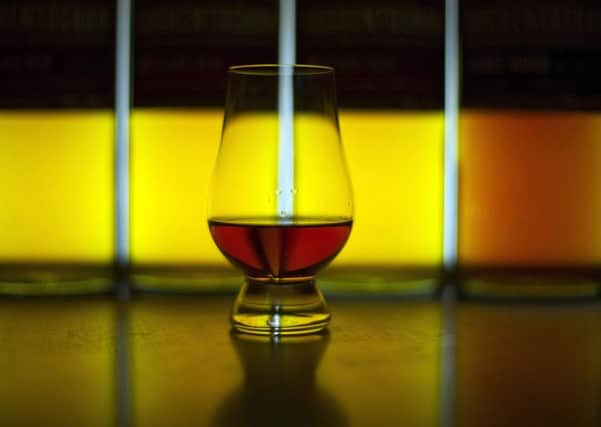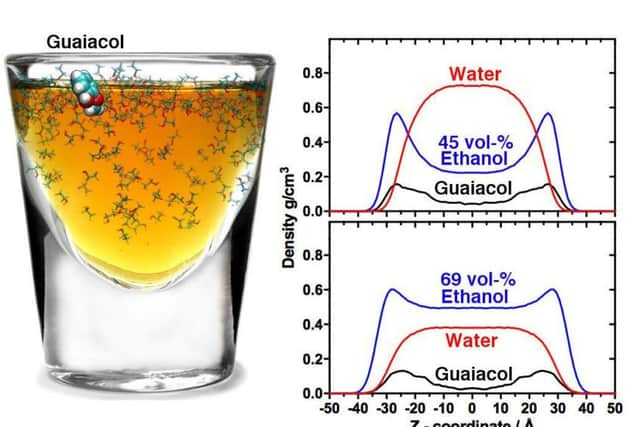Water enhances taste of whisky, scientists claim


The taste of the spirit is improved by dilution because it drives flavour compounds to the surface, the study found.
The question of whether it is right to add water to whisky has been debated for centuries.
Advertisement
Hide AdAdvertisement
Hide AdNow a Swedish team claims to have settled the argument scientifically after showing how alcohol interacts with a chemical key to whisky’s smoky taste. This causes guaiacol - which is also responsible for the flavour of smoke preserved food like bacon, fish and roast coffee - to be driven towards the bottom of a bottle, or glass. But a shot of water forces it back towards the top, providing the full force of guaiacol’s benefits.


Prof Bjorn Karlsson and colleagues said the taste of the chemical, and similar compounds, are enhanced when the spirit is diluted prior to bottling.
He said: “The taste of guaiacol and similar compounds will be more pronounced when whisky is further diluted in the glass.”
Prof Karlsson, a chemist at Linnaeus University, Kalmar, explained the spirit’s distinctive taste is produced by the distillation of fermented grains, ageing - and dilution.
Distilled malt whiskies typically contain around 70% alcohol by volume before it is aged in barrels for at least three years. Some alcohol evaporates during the maturation resulting in an alcohol content of 55–65% of cask strength whisky.


Before bottling, the whisky is diluted to around 40% by the addition of water, which “changes the taste significantly”, said Prof Karlsson.
He added: “Whisky enthusiasts often also add a few drops of water to the spirit before drinking in order to further enhance the taste. Apart from water and alcohols, whiskies contain different organic compounds that contribute to their taste.
“Many whiskies, especially those that are made on the Scottish island of Islay, have a typical smoky taste that develops when malted barley is smoked on peat fire.
Advertisement
Hide AdAdvertisement
Hide Ad“Chemically, the smoky flavour is attributed to phenols, and in particular guaiacol, which is much more common in Scottish whiskies than in American or Irish ones.”
Higher concentrations of guaiacol have been found in Scottish whiskies than in American and Irish ones.
In the study Prof Karlsson and colleague Prof Ran Friedman carried out computer simulations of mixtures of water and pure alcohol, or ethanol, in the presence of guaiacol. At concentrations of alcohol up to 45% , guaicol was more likely to be present at the surface of the liquid, rather than in the bulk.
Prof Karlsson said: “In a glass of whisky it will therefore contributes to both the smell and taste of the spirit.”
Most whisky that has an alcohol level of between 40 and 46% already has some water added anyway. This process is called ‘cutting’ and is done before bottling in order to bring the alcohol down to a more acceptable level for the majority of consumers. The water used is usually spring water that is found locally to the distillery.
Many whisky drinkers believe that you should not add any water to your whisky under any circumstance. This is because you are tasting the whisky in its true natural form with all of the original distillery characteristics and flavours from the cask in which it has been maturing.
But others say adding a few drops of water can open up different, new and subtle flavours, especially when drinking cask strength whiskies that have higher alcohol levels, over 60%, in some cases.
The findings by Prof Karlsson and Prof Friedman, which are published in the latest edition of Scientific Reports, suggest they have been right all along - and could also have implications for gin, rum and brandy. But they said deciding how much water you then add is a matter of personal taste.
Advertisement
Hide AdAdvertisement
Hide Ad“Overall, there is a fine balance between diluting the whisky to taste and diluting the whisky to waste,” added Prof Karlsson.
“This balance will depend on the concentration and types of taste compounds that are characteristic for each whisky. Similar considerations can be used to optimise the alcohol concentration of other spirits including gin, rum and brandy.”
Guaiacol was originally discovered by the Italian chemist Ascanio Sobrero, who is much better known for discovering nitroglycerine. Many plants and insects synthesise guaiacol.